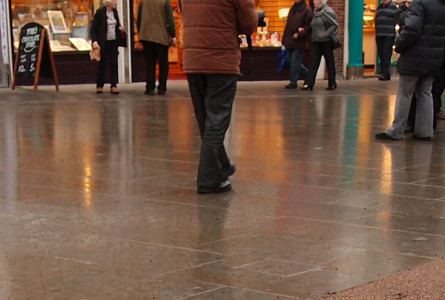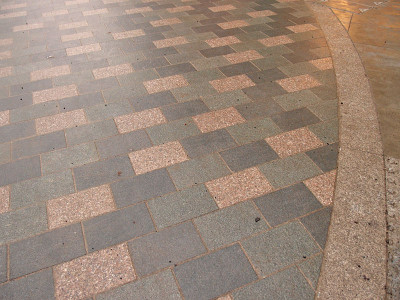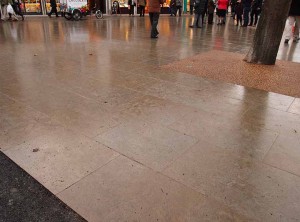As I’m sure most people know by now, the new paving in King’s Square, phase 1 of it, has recently been revealed. I’ve already written about how it fitted in (or didn’t) from what I could see of the visible edges. Now the main area is also visible.
Photos and comments on social media and letters to the Press suggest that the reaction has been 99% negative.
I thought I’d try to find something positive to say.
The very smooth new surface reflects the light on a wet day, which is always a good thing. The reflection from the shop windows is rather pleasing. (It’s also fair to say that the paving they’ve taken up had similar light-reflecting qualities when wet, and maybe just needed a good clean, and repairing.)
It’s obviously natural stone, and it has been beautifully laid, with great attention to detail. I think we can agree on that?
Photos on Twitter showed the tarmac patches near the raised area. Obviously a temporary finish, as this is where extra seating is going. They couldn’t leave a hole, as people would have complained, and it would have been dangerous. And they had to do the work in two phases so as not to disrupt Christmas trading. Work will resume early next year.
What struck me most was how it feels underfoot. I was distracted from looking at it, feeling it with my feet. It was like walking on glass. For a blind person, I imagine they’ll know they’ve arrived in King’s Square. Or think they’ve walked onto a mirror.
This textured edging is also elegant and visually pleasing, and more importantly, presumably useful if you’re blind or partially-sighted, as it indicates the roadway edge.
The main paved area certainly says ‘performance space’. If that’s what it’s saying then that’s good, as that’s what King’s Square is best known for.
Of course very smooth surfaces are also ideal for cafe tables. If that’s what this place is saying then that’s not inspiring at all, and just causes resentment.
Anyone who has followed events in the last year or two will know that the Chocolate Story attraction is keen to have outdoor seating in the square. Has City of York Council remodelled King’s Square for that? Reading online comments and talking to friends it’s clear that many people think so.
The planned programme of paving reinvigoration also seems to many like a shocking waste of money, particularly when essential services are being cut. But the ‘reinvigoration’ will continue, and is planned for other areas. It should perhaps have begun in one of those other areas rather than here. Then we would have been better equipped to know what the end result might look like when we were consulted on the plans for this square.
And of course we were consulted. I wonder how many people knew about that. Not enough, it seems. Many residents feel that they were never consulted, despite the best efforts of the council (and they did, I thought, make a real effort to consult).
But then, after consulting us, they ignored us (and English Heritage) on one particular aspect of the square. Let’s move across the mirror-like smoothness to that particularly controversial part.
The replacement for those old cart tracks and setts.
Which is … awful.
Like I said before, nothing could look as good as that ‘1970s paving’ (laid in the 70s, probably 19th century stonework). But still. Look at it.
I doubt anyone in another forty years will campaign to save this.
I feared this would be nasty when I heard it was to be in three colours, but assumed at least that the blocks would follow the line of the curve in an aesthetically pleasing way. But no. We had a sinuous curve, laid to copy the Newgate paving it joins. Now we have a multi-coloured mess of setts in a weirdly busy pattern.
I’m not going to think about what multi-coloured horrors they’ve got planned for phase 2.
So, let’s run away from that bit and back over to here. Trying to be positive, wasn’t I. So, it’s not finished yet, there’s still a couple of hundred thousand pounds waiting in the kitty to do the rest of the paving and chop the mulberry tree down. Personally I’m more concerned about the imminent demise of a healthy city centre tree than I am about these slabs.
I think at least we can congratulate those who did the actual hard graft on the high standard of work. As anyone who has ever tried to lay paving knows, it’s really difficult. I’ve paved parts of our garden and despite my best efforts never managed to get it properly level.
But then my rather uneven and slightly sloping brick paths fit in well with all the other worn and slightly wonky bits around the back of our Victorian house. Depends I guess whether you want things to fit in or to make a statement.
This place certainly makes a statement. Chris Titley in YorkMix thinks it says ‘Welcome to Milton Keynes’. What does the new look say to you? Comments welcome.
Notes, links
There are many pages on this site on the subject of King’s Square. There’s also an album of photos of the square (about 70 in total) including views of how it used to look.
Note: The photos accompanying Chris Titley’s piece in York Mix show the paving on a dry day, when it looks totally different. Interesting to compare with my photos above.










The multicoloured paving looks like it’s layout was left to the builders – i.e. not specified at all. It would be appalling even in Milton Keynes, never mind King’s Square. One would have thought that such a crucial part of an expensive project would have been designed properly… has anyone got access to the plans?!
Hi Neil, it was carefully planned and designed. Michelle Wyatt, who was campaigning against the removal of the old cart tracks and setts, posted on Facebook some time back about the multi-coloured granite they were going to use. Michelle’s campaign was also featured in an article in York Mix which may be of interest: http://www.yorkmix.com/opinion/kings-square-this-modernisation-didnt-need-doing/
The cart tracks and setts led one into the square from the Shambles and back into the Shambles and seemed to connect the two areas. However, having looked at old pictures of the square – including those on City of York Council planning website – I can see that the setts are fairly recent. It seems sad, though, that this square lost its church and had its old buildings replaced by 1960s nondescript buildings. I signed the petition about the setts. This square could be anywhere in the country, no character at all. The mulberry tree should be retained. another symptom of the current city council, oblivious to the views of York citizens, hell bent on making its mark on the city, seems to have no feeling for the character of York.
I get the feeling I might be in a minority of one here, but I feel that some of the critics of the Kings Square redevelopment has been ridiculous. The new paving has been variously described by its detractors as “bland”, “sterile”, “uniform”, and “soulless”. But how can any of these terms be a legitimate criticism of paving? Because paving should be bland, sterile, uniform and soulless. Paving is not a destination or an attraction. Paving is not supposed to be compelling. Paving is there to cover up the interesting geological and biological features of a space and render the environment underfoot sterile. Sterilising the environment is the very point of paving.
The first time I visited Kings Square after the renovation, I – like many others – went there to look at the paving. But the second time I went, I really didn’t notice it. When in the square I found that my eyes were drawn to buildings and features of interest: The incongruity and diversity of the buildings that make up the Duke of York; the cat on the roof; the bloody Chocolate Story tricycle that shouldn’t be permitted to clutter that environment. I was able to take in so much more as a result of not having to think about – or look at – the paving (and as I’m usually with a two-year-old who sees no inherent peril anywhere, that came as quite a relief).
I think of it as negative space. As in other areas of art and design, the negative space is the part that the eye can ignore which draws it to the features of interest. It actively focuses the eye on the historical interest and beauty that is already there. Does it really matter if the bit we walk on is flat and uniform and uncluttered and safe when it helps us to appreciate the interesting features that the square has?
As for the expense (also much criticised), I don’t know if £490,000 to repave Kings Square is good value (and remember, the work hasn’t been completed yet) as I’m not in the construction industry. Nor have I ever been responsible for costing a civic refurbishment on this scale. But I suspect that applies equally to most of the people complaining about the cost.
I like it.
What I am at a loss with is what the remaining £450,000 is going to be spent off.
I think if that is the bulk of the work done then there is a huge over pricing.
Marc’s perspective is interesting and provocative. I certainly can’t agree with it. Are flagstones really no different to asphalt? Might cobbles or setts just as well be poured concrete? Is the ground really just “negative space”, with structures only mattering visually from eye level upwards? Ground treatments surely make a huge contribution to the quality of public spaces and the way they are experienced. Paving interacts visually with surrounding buildings, responds to varying contours, signals different usages, entrances and exits, expresses places to linger and places to move through. Different materials and surfaces, varying scales of component parts, have a huge visual effect on a space (as well as reflecting practical issues of safety, traffic management and so on). If we take Marc’s argument that the sole purpose of paving is to be “bland, sterile, uniform and soulless” we might as well tarmac everything.
Having been abroad for the last 12 months I have only been able to follow the King’s Square debate online so until yesterday I had no right to comment as I had not seen the new paving in situ. Having now seen it I would like to say that it’s the most hideous thing I have seen in my home city since the Pavement carbuncle was built in the ’60’s. It makes King’s Square look like a cheap, imitation film set. I also see that the junk food vendors have also moved in to further debase what should be a keynote space in the heart of the city. This is not protecting the heritage of York for future generations; it’s simply maximizing the short term revenue and destroying a cohesive space. Would you put a chipboard wardrobe in a Georgian boudoir?
Well, 5 years on and I’m still angry that the Council wasted our money on this tacky paving in our historic city. How jealous I am of the people of Beverley who managed to successfully persuade East Riding of Yorkshire Council to not do the same there (only on an even bigger scale). Who are these awful people who spend our money on cultural vandalism, making our cities and towns look worse. Unforgivable.